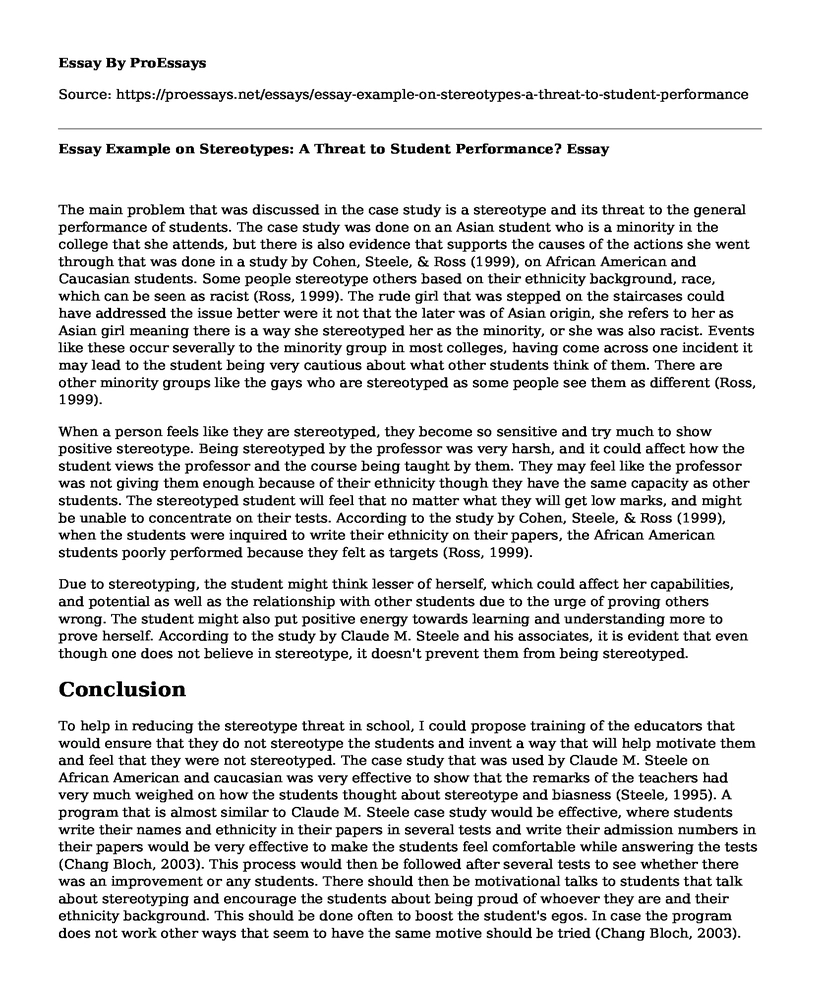The main problem that was discussed in the case study is a stereotype and its threat to the general performance of students. The case study was done on an Asian student who is a minority in the college that she attends, but there is also evidence that supports the causes of the actions she went through that was done in a study by Cohen, Steele, & Ross (1999), on African American and Caucasian students. Some people stereotype others based on their ethnicity background, race, which can be seen as racist (Ross, 1999). The rude girl that was stepped on the staircases could have addressed the issue better were it not that the later was of Asian origin, she refers to her as Asian girl meaning there is a way she stereotyped her as the minority, or she was also racist. Events like these occur severally to the minority group in most colleges, having come across one incident it may lead to the student being very cautious about what other students think of them. There are other minority groups like the gays who are stereotyped as some people see them as different (Ross, 1999).
When a person feels like they are stereotyped, they become so sensitive and try much to show positive stereotype. Being stereotyped by the professor was very harsh, and it could affect how the student views the professor and the course being taught by them. They may feel like the professor was not giving them enough because of their ethnicity though they have the same capacity as other students. The stereotyped student will feel that no matter what they will get low marks, and might be unable to concentrate on their tests. According to the study by Cohen, Steele, & Ross (1999), when the students were inquired to write their ethnicity on their papers, the African American students poorly performed because they felt as targets (Ross, 1999).
Due to stereotyping, the student might think lesser of herself, which could affect her capabilities, and potential as well as the relationship with other students due to the urge of proving others wrong. The student might also put positive energy towards learning and understanding more to prove herself. According to the study by Claude M. Steele and his associates, it is evident that even though one does not believe in stereotype, it doesn't prevent them from being stereotyped.
Conclusion
To help in reducing the stereotype threat in school, I could propose training of the educators that would ensure that they do not stereotype the students and invent a way that will help motivate them and feel that they were not stereotyped. The case study that was used by Claude M. Steele on African American and caucasian was very effective to show that the remarks of the teachers had very much weighed on how the students thought about stereotype and biasness (Steele, 1995). A program that is almost similar to Claude M. Steele case study would be effective, where students write their names and ethnicity in their papers in several tests and write their admission numbers in their papers would be very effective to make the students feel comfortable while answering the tests (Chang Bloch, 2003). This process would then be followed after several tests to see whether there was an improvement or any students. There should then be motivational talks to students that talk about stereotyping and encourage the students about being proud of whoever they are and their ethnicity background. This should be done often to boost the student's egos. In case the program does not work other ways that seem to have the same motive should be tried (Chang Bloch, 2003).
References
Steele, C. M., and Aronson, J. (1995). Stereotype threat and the intellectual test performance of African-Americans. Journal of Personality and Social Psychology, 69, 797-811. https://psycnet.apa.org/doiLanding?doi=10.1037/0022-3514.69.5.797
Chang Bloch, J. (2003). Educating Asian Americans: A challenge to education leaders. Remarks to the US Department of Education. Second Annual OELA Celebrate Our Rising Stars Summit, Hilton Washington Hotel, Washington, DC http://www. ncela. gwu. edu/oela/summit2003/Presentations/asian_american. pdf Last accessed, 4(8), 08.
Cohen, G., Steele, C. M., & Ross, L. D. (1999). Th e mentor's dilemma: Providing critical feedback across the racial divide. Personality and Social Psychology Bulletin, 25, 1302-1318. https://journals.sagepub.com/doi/abs/10.1177/0146167299258011
Cite this page
Essay Example on Stereotypes: A Threat to Student Performance?. (2023, Jun 06). Retrieved from https://proessays.net/essays/essay-example-on-stereotypes-a-threat-to-student-performance
If you are the original author of this essay and no longer wish to have it published on the ProEssays website, please click below to request its removal:
- The Three Main Theoretic Perspectives on How Society Impacts People
- Essay Sample on Racial Divide in United States
- School Administrator and Educator Support of LGBTQ Youth Essay
- Essay Example on Online Dating: Seeking Long-Term Relationships?
- Essay Sample on Parenting Groups: Exploring the Types and Benefits
- Uncovering Community Literacies: Exploring Community Mapping - Essay Sample
- Essay Example on Children and Mobile Phones: Impact of Globalization & Technology







